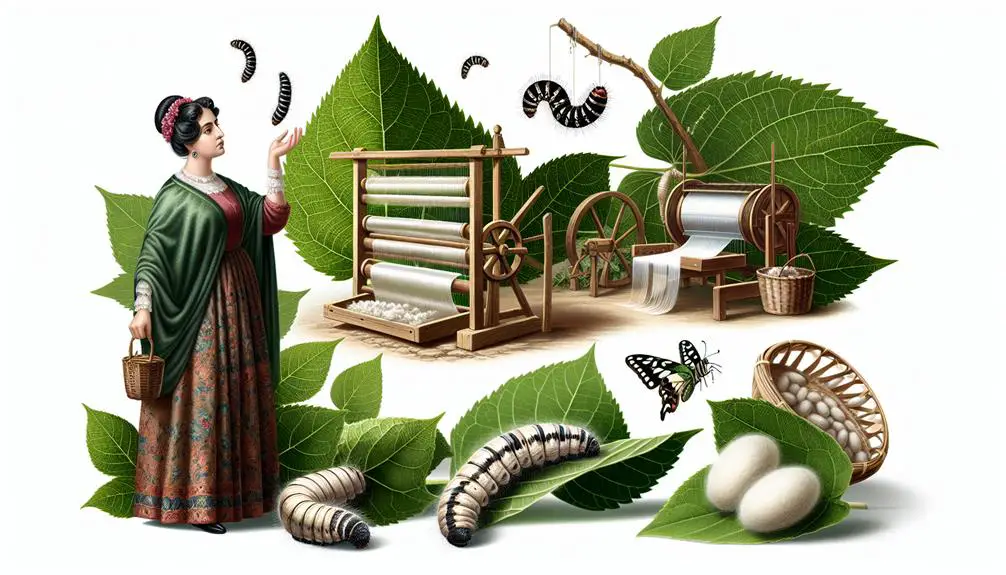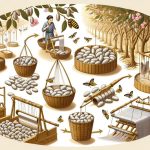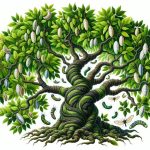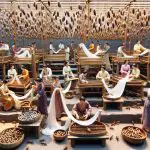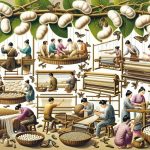I'll tell you all about it! Silk is made from a natural material produced by silkworms as they transform. These remarkable creatures spin fine silk fibers to create their cocoons. The delicate process involves careful harvesting and refining of these fibers. If you're curious to learn more about the fascinating journey from silkworm to silk, keep exploring!
Table of Contents
Key Takeaways
- Silk is made from the cocoons of silkworms.
- Silkworms secrete silk fibers to form their cocoons.
- The process involves harvesting silkworm cocoons.
- Traditional silk production involves boiling or gassing cocoons.
- Ethical concerns arise due to harm inflicted on silkworms in silk production.
Silk Production Process Overview
During the metamorphosis stage, silkworms produce fibers that are used to create silk. The silk production process begins when silkworms spin cocoons made of raw silk threads. These cocoons can contain anywhere between 300 to 900 meters of raw silk thread. To harvest the silk, the cocoons are typically boiled or gassed, which unfortunately results in the death of the silkworms inside. This step is essential for obtaining the silk fibers in their purest form.
Silk production involves a meticulous and labor-intensive process that has been perfected over centuries. The delicate nature of the raw silk threads requires careful handling to guarantee the quality of the final product. Understanding the lifecycle of silkworms and the intricacies of silk production provides a deeper appreciation for this luxurious and sought-after fabric.
As major silk-producing countries like China, India, and Uzbekistan continue to lead the industry, the demand for silk remains steady, highlighting the enduring allure of this prized textile.
Life Cycle of Silkworms
Exploring the intriguing world of silkworms reveals a mesmerizing life cycle marked by transformative stages and intricate silk production.
Silkworm eggs hatch into larvae within about two weeks, starting their journey from the larval to adult stage. During this time, the larvae voraciously consume mulberry leaves and undergo four molting stages.
As they enter the pupal phase, silk production commences. The silkworm larvae then skillfully spin cocoons using silk threads derived from the mulberry leaves they consumed. Each silkworm cocoon contains around 300-900 meters of raw silk thread, showcasing the incredible silk-producing ability of these creatures.
Witnessing the life cycle of silkworms, from their humble beginnings as larvae to their pivotal role in silk production, provides a deep appreciation for the intricate process behind this luxurious fabric.
Ethical Concerns in Silk Industry
One can't ignore the ethical concerns surrounding the silk industry, where thousands of silkworms meet a tragic fate to produce this luxurious fabric. The process involves the silkworms being boiled or gassed alive in their cocoons, causing immense suffering to these creatures that have a central nervous system and the capacity to feel fear and pain.
This high mortality rate and exploitation of sensitive beings raise significant ethical questions within the fashion industry. As consumers become more conscious of the impact of their choices, the demand for humane alternatives to silk has been on the rise. Fortunately, there are readily available and cost-effective options such as nylon, rayon, and other synthetic or plant-based materials that offer a cruelty-free alternative to traditional silk.
Alternatives to Traditional Silk
I'm excited to explore alternatives to traditional silk production, including plant-based options like silk-cotton and ceiba tree filaments.
Synthetic alternatives such as nylon and polyester offer cruelty-free choices without compromising quality or style.
Plant-Based Silk Options
Plant-based silk alternatives offer a sustainable and cruelty-free option for those seeking an ethical and luxurious alternative to traditional silk made from animals. Materials like silk-cotton and ceiba tree filaments provide viable alternatives to silk from Bombyx Mori insects raised for their silk. Polyester, though synthetic, is another substitute for traditional silk, while rayon, a plant-based option, mimics the luxurious feel of silk. Opting for these plant-based silk options supports ethical fashion choices and sustainability.
| Plant-Based Silk Alternatives | Benefits |
|---|---|
| Silk-cotton | Sustainable |
| Ceiba tree filaments | Cruelty-free |
| Polyester | Synthetic |
| Rayon | Luxurious feel |
| Ethical choice |
Synthetic Silk Alternatives
As we explore alternatives to traditional silk, synthetic options like nylon offer a cruelty-free choice for those seeking ethical and sustainable fashion alternatives. Unlike silk, which is derived from animals that produce it, nylon is a synthetic material that doesn't harm any living creatures in its production process.
Additionally, polyester is another synthetic substitute used to make a single, cost-effective, and animal-friendly alternative to silk. For those looking for a more sustainable option, rayon, a plant-based material, is an ethical choice in the fashion industry.
Animal Welfare in Silk Harvesting
In the domain of silk production, the treatment of silkworms during the harvesting process raises significant concerns about animal welfare. Silkworms, while producing silk, are subjected to practices that can harm them and raise ethical questions.
Here are three reasons why animal welfare in silk harvesting is a pressing issue:
- Silkworms are live beings: Silkworms are living creatures that produce silk as a natural part of their life cycle. Harvesting silk often involves killing the silkworms while still alive in their cocoons, causing distress and harm to these animals.
- Sensitivity and pain responses: Studies have shown that silkworms exhibit sensitivity and pain responses, indicating that they can experience suffering. The methods used in silk harvesting can lead to unnecessary harm and suffering for these creatures.
- Ethical concerns: The silk industry has faced criticism for the exploitation and harm inflicted on silkworms during the harvesting process. Advocates for animal welfare emphasize the need to address these ethical concerns and promote alternatives that reduce harm to these insects.
Sustainability in Silk Manufacturing
Silk manufacturing is evolving towards sustainability, emphasizing ethical practices and environmental responsibility in the production process. Sustainable silk production prioritizes animal welfare by minimizing harm to silk moths.
Efforts are being made to reduce the environmental impact of traditional silk farming through sustainable farming methods. Alternative silk materials such as peace silk and vegan silk provide cruelty-free options for conscious consumers. These alternatives support ethical practices in the industry and promote sustainability.
Global Silk Industry Impact
With China leading the way in silk production, the global impact of the silk industry is significant, affecting markets worldwide. The industry has raised concerns about ethical treatment of silkworms and the environmental impact of silk production. Technological advancements play an essential role in increasing silk yield and addressing issues like moth emergence.
- Ethical Treatment: The ethical treatment of silkworms is a pressing concern in the silk industry, as the process of silk production involves boiling cocoons with live pupae inside to obtain the silk threads. This practice raises questions about animal welfare standards and humane treatment.
- Environmental Impact: Silk production can have environmental repercussions, such as pesticide use in mulberry cultivation, water consumption during various stages of production, and waste generation. Sustainable practices are essential to mitigate these impacts and preserve ecosystems.
- Technological Advancements: Innovations in silk production techniques can help reduce environmental burdens, improve efficiency, and address ethical concerns. Advancements like sustainable mulberry cultivation, eco-friendly dyeing processes, and cruelty-free silk alternatives are shaping the future of the industry.
Future of Cruelty-Free Silk
As we look ahead to the future of cruelty-free silk, exciting advancements in sustainable and ethical production methods are paving the way for a more compassionate and environmentally conscious silk industry. The emergence of lab-grown silk proteins and biotechnological advancements holds great promise for creating silk without the need for animal exploitation. These innovations not only cater to the rising demand for vegan silk options in the fashion industry but also address the ethical concerns surrounding traditional silk production.
Sustainable methods are being developed to guarantee that the production of cruelty-free silk minimizes its environmental impact. By embracing these new technologies, the silk industry is moving towards a more sustainable and responsible future. The increasing popularity of vegan silk options reflects a shifting consumer mindset towards supporting ethical and environmentally friendly practices.
With ongoing research and investment in cruelty-free silk, the industry is on the brink of a significant transformation. By embracing these advancements, we can foster a silk industry that's both innovative and compassionate, setting new standards for ethical production in the fashion world.
Frequently Asked Questions
Is Silk Made by Killing Silkworms?
Yes, silk is made by killing silkworms. Around 3,000 silkworms are killed to produce one pound of silk. The process involves boiling or gassing the silkworms alive to extract their silk cocoons, a practice that causes suffering.
Can You Make Silk Without Killing the Worm?
Making silk without harming the silkworm is possible. Through methods like waiting for the moth to emerge naturally, we can extract silk without causing harm, in line with ethical and non-lethal practices.
Do Wasps Make Silk?
Yes, wasps make silk. They produce it during their pupal phase to create protective cocoons for their larvae. While not as well-known as silkworm silk, wasp silk is essential for nest building and survival.
Does All Silk Come From Worms?
Silk is primarily sourced from silkworm cocoons. Alternative cruelty-free options like nylon and rayon exist. Silk production involves boiling or gassing silkworms alive, causing their death. This process raises concerns about animal welfare.
- Why Is Red Velvet Not Red? - April 25, 2024
- How Do You Describe Velvet Fabric? - April 25, 2024
- How Strong Is Velvet? - April 25, 2024

